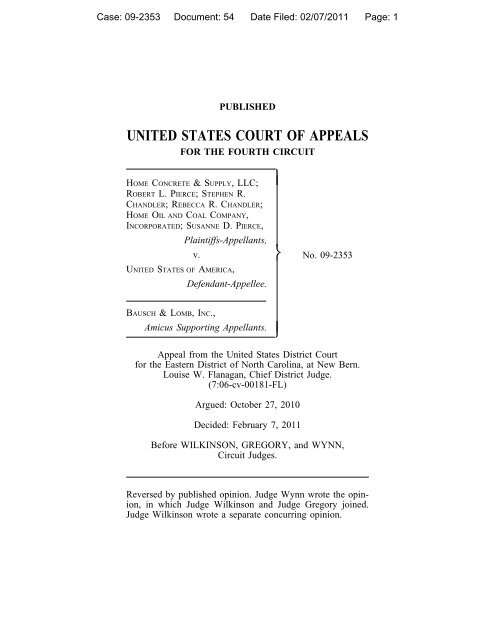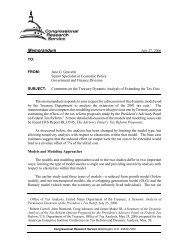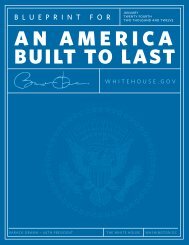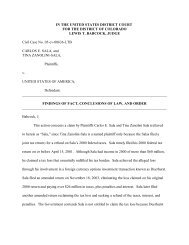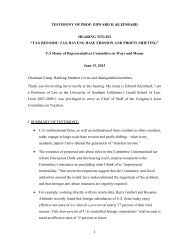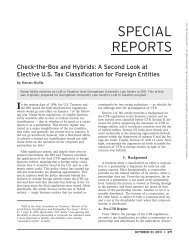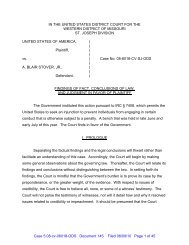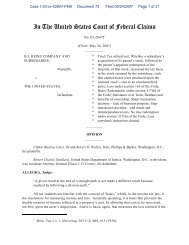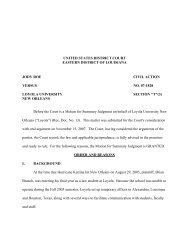Home Concrete & Supply, LLC v. United States
Home Concrete & Supply, LLC v. United States
Home Concrete & Supply, LLC v. United States
You also want an ePaper? Increase the reach of your titles
YUMPU automatically turns print PDFs into web optimized ePapers that Google loves.
Case: 09-2353 Document: 54 Date Filed: 02/07/2011 Page: 1PUBLISHEDUNITED STATES COURT OF APPEALSFOR THE FOURTH CIRCUITHOME CONCRETE & SUPPLY, <strong>LLC</strong>;ROBERT L. PIERCE; STEPHEN R.CHANDLER; REBECCA R. CHANDLER;HOME OIL AND COAL COMPANY,INCORPORATED; SUSANNE D. PIERCE,Plaintiffs-Appellants,UNITED STATES OF AMERICA,⎫⎬v. No. 09-2353Defendant-Appellee.BAUSCH & LOMB, INC.,Amicus Supporting Appellants.⎭Appeal from the <strong>United</strong> <strong>States</strong> District Courtfor the Eastern District of North Carolina, at New Bern.Louise W. Flanagan, Chief District Judge.(7:06-cv-00181-FL)Argued: October 27, 2010Decided: February 7, 2011Before WILKINSON, GREGORY, and WYNN,Circuit Judges.Reversed by published opinion. Judge Wynn wrote the opinion,in which Judge Wilkinson and Judge Gregory joined.Judge Wilkinson wrote a separate concurring opinion.
Case: 09-2353 Document: 54 Date Filed: 02/07/2011 Page: 22 HOME CONCRETE v. UNITED STATESCOUNSELARGUED: Richard Rice, Charles Mark Wiley, WOMBLECARLYLE SANDRIDGE & RICE, P<strong>LLC</strong>, Winston-Salem,North Carolina, for Appellants. Joan Iris Oppenheimer,UNITED STATES DEPARTMENT OF JUSTICE, Washington,D.C., for Appellee. ON BRIEF: Robert T. Numbers, II,WOMBLE CARLYLE SANDRIDGE & RICE, P<strong>LLC</strong>,Winston-Salem, North Carolina, for Appellants. John A.DiCicco, Acting Assistant Attorney General, Gilbert S.Rothenberg, Acting Deputy Assistant Attorney General,Michael J. Haungs, Tax Division, UNITED STATESDEPARTMENT OF JUSTICE, Washington, D.C.; George E.B. Holding, <strong>United</strong> <strong>States</strong> Attorney, Raleigh, North Carolina,for Appellee. Roger J. Jones, Andrew R. Roberson,LATHAM & WATKINS LLP, Chicago, Illinois; Kim MarieBoylan, LATHAM & WATKINS, LLP, Washington, D.C.,for Amicus Supporting Appellants.WYNN, Circuit Judge:OPINIONIn Colony, Inc. v. Commissioner of Internal Revenue, the<strong>United</strong> <strong>States</strong> Supreme Court held that an overstatement ofbasis in assets resulting in an understatement of reported grossincome does not constitute an "omission" from gross incomefor purposes of extending the general three-year statute oflimitations for tax assessments. 357 U.S. 28 (1958). BecauseColony squarely applies to this case, and because we will notdefer to Treasury Regulation § 301.6501(e)-1(e), which waspromulgated during this litigation and, by its own terms, doesnot apply to the tax year at issue, we reverse and hold that thetax assessments at issue here were untimely.I.In 1999, plaintiffs Stephen R. Chandler and Robert L.Pierce were the sole shareholders of plaintiff <strong>Home</strong> Oil and
Case: 09-2353 Document: 54 Date Filed: 02/07/2011 Page: 3HOME CONCRETE v. UNITED STATESCoal Company, Incorporated ("<strong>Home</strong> Oil"). Mr. Pierce contemplatedselling his interest in <strong>Home</strong> Oil and sought professionalfinancial planning advice in anticipation of thetransaction. This financial advice, rendered by several financialplanning firms, included proposals to minimize the taxliability generated by Mr. Pierce’s sale of his interest in <strong>Home</strong>Oil. The ensuing transactions form the grounds of this dispute.Plaintiff <strong>Home</strong> <strong>Concrete</strong> & <strong>Supply</strong>, <strong>LLC</strong> ("<strong>Home</strong> <strong>Concrete</strong>"),a pass-through entity for tax purposes, was formed onApril 15, 1999. Its partners were Mr. Chandler, Mr. Pierce,<strong>Home</strong> Oil, and two trusts established for the benefit of Mr.Pierce’s children (collectively "the taxpayers").On May 13, 1999, each of the taxpayers initiated short sales 1of <strong>United</strong> <strong>States</strong> Treasury Bonds. In the aggregate, the taxpayersreceived $7,472,405 in short sale proceeds. Four dayslater, the taxpayers transferred the short sale proceeds andmargin cash to <strong>Home</strong> <strong>Concrete</strong> as capital contributions. Bytransferring the short sale proceeds to <strong>Home</strong> <strong>Concrete</strong> as capitalcontributions, the taxpayers created "outside basis" equalto the amount of the proceeds contributed. 2 The next day, May18, 1999, <strong>Home</strong> <strong>Concrete</strong> closed the short sales by purchasingand returning essentially identical Treasury Bonds on theopen market at an aggregate purchase price of $7,359,043.1 A "short sale" is a "sale of a security that the seller does not own orhas not contracted for at the time of sale, and that the seller must borrowto make delivery." Black’s Law Dictionary 1456 (9th ed. 2009). To closethe short sale, "‘[t]he short seller is obligated . . . to buy an equivalentnumber of shares [or substantially identical security] in order to return theborrowed [property]. In theory, the short seller makes this covering purchaseusing the funds he received from selling the borrowed [property].’"Kornman & Assocs., Inc. v. <strong>United</strong> <strong>States</strong>, 527 F.3d 443, 450 (5th Cir.2008) (quoting Zlotnick v. TIE Commc’ns, 836 F.2d 818, 820 (3d Cir.1988)).2 A partner’s basis in her partnership interest is called "outside basis,"and a partnership’s basis in its assets is referred to as its "inside basis."Kornman, 527 F.3d at 456 n.12; see also 26 U.S.C. §§ 722-23.3
Case: 09-2353 Document: 54 Date Filed: 02/07/2011 Page: 44 HOME CONCRETE v. UNITED STATESOn June 11, 1999, <strong>Home</strong> Oil transferred substantially all ofits business assets to <strong>Home</strong> <strong>Concrete</strong> as a capital contribution.Three days later, the taxpayers (except <strong>Home</strong> Oil) transferredpercentages of their respective partnership interests in <strong>Home</strong><strong>Concrete</strong> to <strong>Home</strong> Oil as capital contributions to <strong>Home</strong> Oil.On August 31, 1999, <strong>Home</strong> <strong>Concrete</strong> sold substantially all ofits assets to a third-party purchaser for $10,623,348.In April 2000, <strong>Home</strong> <strong>Concrete</strong> and the taxpayers timelyfiled their tax returns for the 1999 tax year. <strong>Home</strong> <strong>Concrete</strong>elected to adjust, or "step-up," its inside basis under 26 U.S.C.("I.R.C.") § 754 to equal the taxpayers’ outside bases. SeeI.R.C. § 743(b)(1). <strong>Home</strong> <strong>Concrete</strong> then adjusted its insidebasis to $10,527,350.53, including the amount of short saleproceeds earlier contributed by the taxpayers. As a result,<strong>Home</strong> <strong>Concrete</strong> reported a modest $69,125.08 gain from thesale of its assets.<strong>Home</strong> <strong>Concrete</strong>’s 1999 tax return reported the basic componentsof the transactions. Its § 754 election form gave, foreach partnership asset, an itemized accounting of the partnership’sinside basis, the amount of the basis adjustment, andthe post-election basis. The sum of the post-election bases isindicated at the end of the form. On its face, <strong>Home</strong> <strong>Concrete</strong>’sreturn also showed a "Sale of U.S. Treasury Bonds" acquiredon May 18, 1999 at a cost of $7,359,043, and a sale of thoseBonds on May 19, 1999 for $7,472,405. The return alsoreported the resulting gain of $113,362. Similarly, the taxpayers’individual returns showed that "during the year the proceedsof a short sale not closed by the taxpayer in this tax yearwere received."Notwithstanding these disclosures, the Internal RevenueService ("IRS") did not investigate the taxpayers’ transactionsuntil June 2003. The IRS issued a summons to Jenkins & Gilchrist,P.C., the law firm that assisted the taxpayers with thetransactions, on June 19, 2003. The parties agree that substan-
Case: 09-2353 Document: 54 Date Filed: 02/07/2011 Page: 5HOME CONCRETE v. UNITED STATEStial compliance with the IRS summons did not occur until atleast May 17, 2004.As a result of the investigation, on September 7, 2006 theIRS issued a Final Partnership Administrative Adjustment("FPAA"), decreasing to zero the taxpayers’ reported outsidebases in <strong>Home</strong> <strong>Concrete</strong> and thereby substantially increasingthe taxpayers’ taxable income. Specifically, the IRS reasonedthatthe purported partnership was formed and availed ofsolely for purposes of tax avoidance by artificiallyoverstating basis in the partnership interests of itspurported partners. . . . [T]he acquisition of anyinterest in the purported partnership by the purportedpartner, short sales of Treasury Notes, the transfer ofproceeds from short sales of Treasury Notes or otherassets to a partnership in return for a partnershipinterest, the purchase or disposition of assets by thepartnership, and the distribution of those assets orproceeds from the disposition of those assets to thepurported partners, and the subsequent sale of thoseassets to generate a loss, all within a period of 8months, had no business purpose other than taxavoidance, lacked economic substance, and, in factand substance, constitutes an economic sham for federalincome tax purposes. Accordingly, the partnershipand the transactions described above shall bedisregarded in full and (1) any purported lossesresulting from these transactions are not allowable asdeductions; and (2) increases in basis of assets arenot allowed to eliminate gain for federal income taxpurposes.Accordingly, <strong>Home</strong> <strong>Concrete</strong> deposited $1,392,118 with theIRS and sued in the District Court for the Eastern District ofNorth Carolina to recover that amount, alleging that the5
Case: 09-2353 Document: 54 Date Filed: 02/07/2011 Page: 66 HOME CONCRETE v. UNITED STATESFPAA was barred by the general three-year limitations periodin I.R.C. § 6501(a).In response, the IRS contended that the FPAA was timelyunder the six-year limitations period in § 6501(e)(1)(A). TheIRS invoked the extended statute of limitations arguing that<strong>Home</strong> <strong>Concrete</strong> "omit[ted] from gross income an amountproperly includable therein" and which exceeded 25% of theamount of gross income stated in <strong>Home</strong> <strong>Concrete</strong>’s 1999 taxreturn. <strong>Home</strong> <strong>Concrete</strong> & <strong>Supply</strong>, <strong>LLC</strong> v. <strong>United</strong> <strong>States</strong>, 599F. Supp. 2d 678, 683 (E.D.N.C. 2008). There was no disputethat if an amount had been omitted from <strong>Home</strong> <strong>Concrete</strong>’sreturn, that amount exceeded the 25% threshold. Likewise,there was no dispute that the FPAA would have been timelyunder the six-year statute of limitations, which would havebeen tolled beginning six months after the date the summonsissued to the date of compliance. Id. at 681 n.5; see alsoI.R.C. § 7609(e)(2). By the district court’s calculation, "thelimitations period for the 1999 tax returns was suspendedfrom December 20, 2003, until May 17, 2004 . . . . Thus, asix-year statute, tolled, would not have run even under thismost restrictive interpretation of the record until" September14, 2006. <strong>Home</strong> <strong>Concrete</strong> & <strong>Supply</strong>, 599 F. Supp. 2d at 681n.5.On the other hand, the taxpayers argued that the six-yearstatute of limitations was inapplicable because <strong>Home</strong> <strong>Concrete</strong>’sallegedly overstated basis did not constitute an omissionfrom gross income. And even if it had been an omission,the taxpayers argued, their tax returns collectively made adequatedisclosure of the transactions such that they were entitledto the safe harbor of the three-year statute of limitationsunder § 6501(e)(1)(B)(ii) (hereafter "safe harbor provision").Id. at 683.Thereafter, the district court granted partial summary judgmentin the IRS’s favor, ruling that "where a taxpayer overstatesbasis and, as a result, leaves an amount out of gross
Case: 09-2353 Document: 54 Date Filed: 02/07/2011 Page: 7HOME CONCRETE v. UNITED STATESincome, the taxpayer ‘omits from gross income an amountproperly includible therein’ for purposes of § 6501(e)(1)(A)."Id. at 687. The court ordered further briefing on, among otherissues, whether the taxpayers adequately disclosed any omittedamount such that the safe harbor provision applied. Afterconsidering the supplemental briefs, 3the district court ruledthat the taxpayers failed to make adequate disclosure andtherefore could not invoke the safe harbor provision. Accordingly,the district court concluded that the FPAA was timelyunder the six-year statute of limitations in § 6501(e)(1)(A).<strong>Home</strong> <strong>Concrete</strong> and the taxpayers appealed.II.On appeal, <strong>Home</strong> <strong>Concrete</strong> and the taxpayers argue thatColony establishes that an overstated tax basis does not constitutean omission from gross income for purposes of extendingthe limitations period for assessments. We review thisquestion of law de novo. Blaustein & Reich, Inc. v. Buckles,365 F.3d 281, 286 (4th Cir. 2004)In Colony, the IRS alleged that a taxpayer "understated thegross profits on the sales of certain lots of land for residentialpurposes as a result of having overstated the ‘basis’ of suchlots by erroneously including in their cost certain unallowableitems of development expense." 357 U.S. at 30. The IRS furthercontended that the amount left out of gross incomebecause of the overstated basis exceeded 25% of the amountof gross income stated in the relevant tax returns. The IRSargued that its assessments were therefore timely under theextended five-year statute of limitations in former I.R.C.§ 275(c). Id. at 30-31. That section stated that:3 In their supplemental brief to the district court, the taxpayers stipulated"for purposes of resolving the [cross-motions for summary judgment]only, that ‘they overstated the tax basis of the assets that [<strong>Home</strong> <strong>Concrete</strong>]sold in 1999 resulting in an omission [ ] from gross income in excess of25 percent of the stated gross income amount.’"7
Case: 09-2353 Document: 54 Date Filed: 02/07/2011 Page: 88 HOME CONCRETE v. UNITED STATESIf the taxpayer omits from gross income an amountproperly includable therein which is in excess of 25per centum of the amount of gross income stated inthe return, the tax may be assessed, or a proceedingin court for the collection of such tax may be begunwithout assessment, at any time within 5 years afterthe return was filed.26 U.S.C. § 275(c) (1939).The Supreme Court in Colony acknowledged that former§ 275(c) was ambiguous and did not clearly answer whetherCongress intended an overstated basis to constitute an omissionfrom gross income stated in the return. The Court foundin the legislative history "persuasive evidence that Congresswas addressing itself to the specific situation where a taxpayeractually omitted some income receipt or accrual in his computationof gross income, and not more generally to errors inthat computation arising from other causes." Id. at 33.According to the Court, "in enacting [former §] 275(c) Congressmanifested no broader purpose than to give the Commissioneran additional two years to investigate tax returns incases where, because of a taxpayer’s omission to report sometaxable item, the Commissioner is at a special disadvantage indetecting errors." Id. at 37. The Court therefore refused toconstrue "omits" broadly and instead restricted its applicabilityto situations where taxpayers actually fail to reportincome.Notably, in dicta, the Supreme Court also stated that itsconclusion was "in harmony with the unambiguous languageof section 6501(e)(1)(A)"—the section at issue in this case.Id. (emphasis added). In 1954, Congress recodified former§ 275(c) at § 6501(e)(1)(A). Congress extended the limitationsperiod from five years to six, and added the followingadditional subsections:(i) In the case of a trade or business, the term "grossincome" means the total of the amounts received or
Case: 09-2353 Document: 54 Date Filed: 02/07/2011 Page: 9HOME CONCRETE v. UNITED STATESaccrued from the sale of goods or services (if suchamounts are required to be shown on the return)prior to diminution by the cost of such sales or services;and9(ii) In determining the amount omitted from grossincome, there shall not be taken into account anyamount which is omitted from gross income stated inthe return if such amount is disclosed in the return,or in a statement attached to the return, in a manneradequate to apprise the Secretary or his delegate ofthe nature and amount of such item.Section 6501(e)(1)(A) and former § 275(c) are otherwiseessentially identical.In this case, the district court distinguished Colony on theground that its holding is limited to cases in which the taxpayeris a trade or business selling goods or services. <strong>Home</strong><strong>Concrete</strong> & <strong>Supply</strong>, 599 F. Supp. 2d at 685-86; accord, e.g.,Beard v. Comm’r, No. 09-3741, slip op. at 8-9 (7th Cir. Jan.26, 2011) (holding that Colony only applies in the trade orbusiness context); CC&F W. Operations Ltd. P’ship v.Comm’r, 273 F.3d 402, 406 n.2 (1st Cir. 2001) (noting, indicta, the "arguable implication" that the holding of Colonyapplies only to sales of goods or services by a trade or business).In doing so, the district court relied heavily upon theCourt of Federal Claims’ decision in Salman Ranch, Ltd. v.<strong>United</strong> <strong>States</strong>, 79 Fed. Cl. 189 (2007), which has since beenreversed by the Federal Circuit. 573 F.3d 1362 (Fed. Cir.2009). The Federal Circuit expressly refused to limit Colony’sapplication to sales of goods or services by a trade or businessbecause nothing in Colony suggests such a limitation. SalmanRanch, 573 F.3d at 1373; see also Bakersfield Energy Partners,L.P. v. Comm’r, 568 F.3d 767, 778 (9th Cir. 2009)("There is no ground for suggesting that the [Colony] Courtintended the same language in § 275(c) to apply differently totaxpayers in a trade or business than to other taxpayers.");
Case: 09-2353 Document: 54 Date Filed: 02/07/2011 Page: 1010 HOME CONCRETE v. UNITED STATESGrapevine Imports, Ltd. v. <strong>United</strong> <strong>States</strong>, 77 Fed. Cl. 505, 511(2007) ("[T]his court sees no basis for limiting the SupremeCourt’s decision [in Colony] to sales of goods or services bya trade or business."); UTAM, Ltd. v. Comm’r, 98 T.C.M.(CCH) 422, *3 (2009) (same).Like the Ninth and Federal Circuits, we hold that theSupreme Court in Colony straightforwardly construed thephrase "omits from gross income," unhinged from any dependencyon the taxpayer’s identity as a trade or business sellinggoods or services. There is, therefore, no ground to concludethat the holding in Colony is limited to cases involving a tradeor business selling goods or services. See Salman Ranch, 573F.3d at 1373 ("We are not prepared to conclude—based simplyupon the Court’s reference to ambiguity in § 275(c) andthe lack thereof in § 6501(e)(1)(A)—that the Court’s faciallyunqualified holding nevertheless carries with it a qualification.").Further, the Supreme Court’s discussion of the legislativehistory behind former § 275(c) is equally compelling withregard to current § 6501(e)(1)(A). The language the Courtconstrued in former § 275(c)—"omits from gross income anamount properly includable therein"—is identical to the languageat issue in § 6501(e)(1)(A). Because there has been nomaterial change between former § 275(c) and current§ 6501(e)(1)(A), and no change at all to the most pertinentlanguage, we are not free to construe an omission from grossincome as something other than a failure to report "someincome receipt or accrual." Colony, 357 U.S. at 33; see alsoBakersfield Energy Partners, L.P., 568 F.3d at 778 (concludingthat Colony forecloses the argument that an overstatedbasis can constitute an omission from gross income for purposesof extending the statute of limitations under§ 6501(e)(1)(A)); Salman Ranch, 573 F.3d at 1377 (same).Thus, we join the Ninth and Federal Circuits and concludethat Colony forecloses the argument that <strong>Home</strong> <strong>Concrete</strong>’s
Case: 09-2353 Document: 54 Date Filed: 02/07/2011 Page: 11HOME CONCRETE v. UNITED STATESoverstated basis in its reporting of the short sale proceedsresulted in an omission from its reported gross income.III.The IRS presses another path around Colony. After concludingthat the IRS’s position regarding the meaning of"omits" was barred by Colony, the Ninth Circuit commentedthat the "IRS may have the authority to promulgate a reasonablereinterpretation of an ambiguous provision of the taxcode, even if its interpretation runs contrary to the SupremeCourt’s ‘opinion as to the best reading’ of the provision."Bakersfield Energy Partners, 568 F.3d at 778 (quoting Nat’lCable & Telecomms. Ass’n v. Brand X Internet Servs., 545U.S. 967, 982-83 (2005)).Perhaps in response to the Ninth Circuit’s cue, the IRS promulgateda temporary regulation on September 28, 2009,which became final during the pendency of this appeal. Treas.Reg. § 301.6501(e)-1. The IRS claims that this regulation isentitled to controlling deference under Chevron U.S.A. Inc. v.Natural Resources Defense Council, Inc., 467 U.S. 837(1984).The regulation states that:(iii) For purposes of paragraph (a)(1)(i) of this section,the term gross income, as it relates to anyincome other than from the sale of goods or servicesin a trade or business, has the same meaning as providedunder section 61(a), and includes the total ofthe amounts received or accrued, to the extentrequired to be shown on the return. In the case ofamounts received or accrued that relate to the dispositionof property, and except as provided in paragraph(a)(1)(ii) of this section, gross income meansthe excess of the amount realized from the dispositionof the property over the unrecovered cost or11
Case: 09-2353 Document: 54 Date Filed: 02/07/2011 Page: 1212 HOME CONCRETE v. UNITED STATESother basis of the property. Consequently, except asprovided in paragraph (a)(1)(ii) of this section, anunderstated amount of gross income resulting froman overstatement of unrecovered cost or other basisconstitutes an omission from gross income for purposesof section 6501(e)(1)(A).. . .(e) Effective/applicability date—(1) Income Taxes.Paragraph (a) of this section applies to taxable yearswith respect to which the period for assessing taxwas open on or after September 24, 2009.Treas. Reg. § 301.6501(e)-1(a)(1)(iii)-1(e)(1) (2010). The IRSasks us to apply the regulation retroactively to produce theresult it desires in this case. We decline to do so for severalreasons.First, the 1999 tax year at issue in this case, for which taxreturns were due by April 2000, is well beyond the reach ofthe regulation’s express period of applicability. Even assumingarguendo that the six-year statute of limitations applied,pursuant to the regulation, the "period for assessing tax"would have expired, according to the district court’s unchallengedfinding, on September 14, 2006. Thus, the period forassessing tax for the 1999 tax year expired long before September24, 2009. By its own terms, the regulation does notapply here. 44 In UTAM, the Tax Court noted that the IRS (curiously) did not rely onthe temporary regulation, even though it had been promulgated while thatcase was still pending. 98 T.C.M. (CCH) at *1 n.2. We observe that thetimeline in this case is virtually identical to the timeline in UTAM: TheIRS issued an FPAA on October 13, 2006, alleging that the taxpayer hadomitted gross income by overstating basis in its tax return for the 1999 taxyear. Id. at *1-2. The IRS did not ask the Tax Court to apply the temporaryregulation retroactively in UTAM yet asks this Court to do so in this factuallyanalogous case.
Case: 09-2353 Document: 54 Date Filed: 02/07/2011 Page: 13HOME CONCRETE v. UNITED STATESThe IRS urges a different interpretation of the regulation’sapplicability clause in the preamble to Treasury Decision9511. The preamble suggests that the "six-year period forassessing tax" in § 6501(e)(1) remains open for "all taxableyears . . . that are the subject of any case pending before anycourt of competent jurisdiction (including the <strong>United</strong> <strong>States</strong>Tax Court and Court of Federal Claims) in which a decisionhad not become final (within the meaning of [26 U.S.C. §]7481)." Because this case was not finally resolved as of September24, 2009, the IRS argues that § 6501(e)(1)’s six-yearperiod for assessing tax remains open and Treasury Regulation§ 301.6501(e)-1(e) applies. We cannot agree.With this logic, the IRS attempts to re-draft I.R.C. § 6501.In the statute, Congress made clear that the window for taxassessments, barring special circumstances, closes after threeyears. I.R.C. § 6501(a). In the event of an omission, the windowcloses after six years. I.R.C. § 6501(e). And Congressspecifically listed circumstances, such as fraud, in which theassessment window remains open without limitation. Id.§ 6501(c). Congress unambiguously stated its intent to closethe period for assessing tax within six years after a return isfiled, except in cases of fraud. Accordingly, the IRS’s argumentthat the period for assessing tax is open—or indeed maybe re-opened, as would be the case here—so long as litigationis pending is contrary to the clearly and unambiguouslyexpressed intent of Congress and must fail. <strong>United</strong> <strong>States</strong> v.Mead, 533 U.S. 218, 227 (2001) (stating that an agency’sinterpretation is not binding on courts if it is "manifestly contraryto the statute"). Not surprisingly, the Tax Court rejectedthe same argument as to the substantially identical applicabilityclause in the temporary regulation. Intermountain Ins.Serv. of Vail, <strong>LLC</strong> v. Comm’r, 134 T.C. No. 11, *4-6 (2010)(rejecting the IRS’s argument as circular and contrary to theplain language of the regulations).Second, even putting the applicability clause aside, Chevrondeference is warranted only when a treasury regulation13
Case: 09-2353 Document: 54 Date Filed: 02/07/2011 Page: 1414 HOME CONCRETE v. UNITED STATESinterprets an ambiguous statute. Mayo Found. for Med. Educ.& Research v. <strong>United</strong> <strong>States</strong>, 562 U.S. ___, ___, No. 09-837,slip op. at 6-7 (Jan. 11, 2011); see also Brand X InternetServs., 545 U.S. at 980; Chevron, 467 U.S. at 842-43. Whilewe are aware that lower courts are divided regarding whetheran overstated basis constitutes an omission from grossincome, the Supreme Court’s reference to "the unambiguouslanguage of section 6501(e)(1)(A)" cannot be ignored. Colony,357 U.S. at 37 (emphasis added). Because the regulationhere interprets "omits from gross income" under§ 6501(e)(1)(A), and the Supreme Court declared that statuteunambiguous, we do not believe that the regulation is entitledto controlling deference. See Chevron, 467 U.S. at 842-43 ("Ifthe intent of Congress is clear, that is the end of the matter;for the courts, as well as the agency, must give effect to theunambiguously expressed intent of Congress.").Finally, we are not persuaded by the IRS’s argument thatthe regulation should apply retroactively to this case as a clarificationof law established in Colony and other cases. TheSupreme Court has acknowledged that a subsequent agencyinterpretation of an ambiguous statute may displace an earlierjudicial construction of the same provision. Brand X InternetServs., 545 U.S. at 982-83. But again, the Supreme Courtstated in Colony that § 6501(e)(1)(A) is unambiguous as tothe very issue to which the regulation purports to speak. Theregulation is not, therefore, a mere clarification. Rather, ifapplied, the regulation would change the law governing thetaxpayers’ 1999 tax returns and thereby subject the taxpayersto liability to which they would not have been subject underpre-regulation law. See <strong>United</strong> <strong>States</strong> v. Capers, 61 F.3d 1100,1110 (4th Cir. 1995) (declining to apply an amendment to the<strong>United</strong> <strong>States</strong> Sentencing Guidelines retroactively because theamendment changed Fourth Circuit law so as to deprive thedefendant of a benefit to which he would have been entitledunder pre-amendment law).Because Colony was established law when the taxpayersfiled their returns in April 2000, we refuse to apply Treasury
Case: 09-2353 Document: 54 Date Filed: 02/07/2011 Page: 15HOME CONCRETE v. UNITED STATESRegulation § 301.6501(e)-1(e), which purports to establish arule contrary to Colony to subject the taxpayers to theextended limitations period ten years later. See Levy v. SterlingHolding Co., 544 F.3d 493, 506 (3d Cir. 2008) ("[W]herea new rule constitutes a clarification—rather than a substantivechange—of the law as it existed beforehand, the applicationof that new rule to pre-promulgation conduct necessarilydoes not have an impermissible retroactive effect"); cf. Smileyv. Citibank (South Dakota), N.A., 517 U.S. 735, 744 n.3(1996) (stating that an agency interpretation does not have animpermissible retroactive effect where there was previouslyno clear agency guidance).IV.In sum, we conclude that the Supreme Court’s holding inColony applies to § 6501(e)(1)(A). An overstated basis inproperty is not an omission from gross income that extendsthe limitations period in § 6501(e)(1)(A). Accordingly, <strong>Home</strong><strong>Concrete</strong>’s overstated basis in the short sale proceeds did nottrigger the six-year statute of limitations. Moreover, TreasuryRegulation § 301.6501(e)-1(e), by the plain terms of its applicabilityclause, does not apply to the tax year at issue in thiscase and is furthermore not entitled to deference. The generalthree-year statute of limitations in § 6501(a) applies, makingthe FPAA here untimely. We reverse the district court’s judgmentto the contrary. 5WILKINSON, Circuit Judge, concurring:REVERSEDI am happy to concur in Judge Wynn’s fine opinion in thiscase. The Chevron test is straightforward enough when itcomes to post-Chevron cases. But it is sometimes difficult to5 In light of this holding, we need not reach the parties’ argumentsregarding the safe harbor provision.15
Case: 09-2353 Document: 54 Date Filed: 02/07/2011 Page: 1616 HOME CONCRETE v. UNITED STATESdetermine whether pre-Chevron decisions are based upon"Chevron step one" (the plain command of the statute) orupon "Chevron step two" (a permissible construction of thestatute). Mayo Found. for Med. Educ. & Research v. <strong>United</strong><strong>States</strong>, No. 09-837, slip op. at 6-7 (U.S. Jan. 11, 2011). CertainlyJustice Harlan in Colony, Inc. v. Commissioner, 357U.S. 28 (1958), had no occasion to ponder the permutationsof the Chevron test, which came down in 1984.Here, however, I am persuaded that the Supreme Courtrested its judgment in Colony on the plain language of thestatute, which then, as now, stated that the extended statute oflimitations for assessing tax liability applies "[i]f the taxpayeromits from gross income an amount properly includibletherein." 26 U.S.C. § 275(c) (1939) (emphasis added); see 26U.S.C. § 6501(e)(1)(A) (current version). In other words, Ibelieve that Colony was decided under Chevron step one.Lawyers of course are adept at finding ambiguity, and languageof course is by its nature imprecise. One need not consulta dictionary, however, to understand that the plainmeaning of "omit" is "to leave out" or "to fail to mention."The taxpayers here did not omit, leave out, or fail to mentiontheir transaction. Instead, they provided the details on theirreturns. See Majority Op. at 4. To be sure, the IRS asserts thatthe returns overstated <strong>Home</strong> <strong>Concrete</strong>’s basis and thus understatedthe overall tax liability resulting from the sale of itsassets. But as the Court noted in Colony, if Congress had beenconcerned with that problem, "it could have chosen anotherverb such as ‘reduces’ or ‘understates,’ either of which wouldhave pointed significantly in the Commissioner’s direction."Colony, 357 U.S. at 32.I recognize there is some language in Colony suggestingthat the Court looked at legislative history or thought that§ 275(c) was ambiguous. See Colony, 357 U.S. at 33("Although we are inclined to think that the statute on its facelends itself more plausibly to the taxpayer’s interpretation, it
Case: 09-2353 Document: 54 Date Filed: 02/07/2011 Page: 17HOME CONCRETE v. UNITED STATEScannot be said that the language is unambiguous. In these circumstanceswe turn to the legislative history of § 275(c).").But that language seems to me secondary in importance to thethrust of the opinion and to the Court’s argument that "inenacting § 275(c) Congress manifested no broader purposethan to give the Commissioner [additional time] to investigatetax returns in cases where, because of a taxpayer’s omissionto report some taxable item, the Commissioner is at a specialdisadvantage in detecting errors." Id. at 36. More importantly,as Judge Wynn notes, the Court observed that its decision was"in harmony with the unambiguous language of" 26 U.S.C.§ 6501(e)(1)(A), the successor provision to § 275(c) and theprovision at issue here. See id. at 37 (emphasis added).I appreciate that Chevron and National Cable & TelecommunicationsAss’n v. Brand X Internet Services, 545 U.S. 967(2005), afford agencies considerable discretion in their areasof expertise. As Brand X put it, "Chevron established a presumptionthat Congress, when it left ambiguity in a statutemeant for implementation by an agency, . . . desired theagency (rather than the courts) to possess whatever degree ofdiscretion the ambiguity allows." Brand X, 545 U.S. at 982(internal quotations and citation omitted). The SupremeCourt’s recent decision in Mayo Foundation likewise affordsfull Chevron deference to Treasury Regulations, concludingthat the Treasury Department’s interpretations of ambiguousstatutes will stand if they are "a ‘reasonable interpretation’ ofthe enacted text." Mayo Found., slip op. at 12 (quoting Chevron,467 U.S. at 844). Given the fact that government todayis an enterprise of unprecedented complexity, this makes perfectsense. Nor do judges harbor any desire to impair the missionof the IRS in a day of staggering budget deficits.Yet it remains the case that agencies are not a law untothemselves. No less than any other organ of government, theyoperate in a system in which the last words in law belong toCongress and the Supreme Court. What the IRS seeks to doin extending the statutory limitations period goes against what17
Case: 09-2353 Document: 54 Date Filed: 02/07/2011 Page: 1818 HOME CONCRETE v. UNITED STATESI believe are the plain instructions of Congress, which havenot been changed, and the plain words of the Court, whichhave not been retracted. See Colony, 357 U.S. at 37.This seems to me something of an inversion of the universeand to pass the point where the beneficial application ofagency expertise gives way to a lack of accountability and arisk of arbitrariness. We do not stand alone in reaching thisdetermination; other courts have similarly rebuffed the IRS’srepeated attempts to adopt the six-year statute of limitationsfor omissions of gross income so as to cover misleading statementsin tax returns that would result in tax deficiencies. SeeSalman Ranch Ltd. v. <strong>United</strong> <strong>States</strong>, 573 F.3d 1362, 1372-74(Fed. Cir. 2009); Bakersfield Energy Partners, L.P. v.Comm’r, 568 F.3d 767, 778 (9th Cir. 2009); GrapevineImports, Ltd. v. <strong>United</strong> <strong>States</strong>, 77 Fed. Cl. 505, 511-12 (2007);Intermountain Ins. Serv. of Vail, <strong>LLC</strong> v. Comm’r, 134 T.C.No. 11, at *6-*8 (2010). These courts have recognized thatregardless of whether the IRS’s position is sound as a matterof policy, it is simply not the law.We have been told many times to leave to the Court "theprerogative of overruling its own decisions." See Rodriguezde Quijas v. Shearson/Am. Express, Inc., 490 U.S. 477, 484(1989). If that injunction has been issued to the circuit courts,it assuredly applies to agencies in situations where the Courthas interpreted the plain language of a statutory command.Maybe Congress will conclude at some point that the six-yearperiod should apply to declarations that fall short of omissionsor the Court may decide that Colony was somehow, after all,a Chevron step two case. But those decisions are neither oursnor the agency’s to make. Chevron, Brand X, and morerecently, Mayo Foundation rightly leave agencies with a largeand beneficial role, but they do not leave courts with no rolewhere the very language of the law is palpably at stake. Thereis a balance to be struck here, and courts still must play a partin determining where "here" is. The disruption of that balancein this case seems clear and evident.


